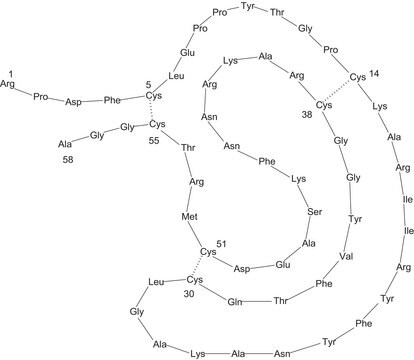Products may be shipped at a different temperature than the recommended long-term storage temperature. If the product quality is sensitive to short-term exposure to conditions other than the recommended long-term storage, it will be shipped on wet or dry-ice. If the product quality is NOT affected by short-term exposure to conditions other than the recommended long-term storage, it will be shipped at ambient temperature. As shipping routes are configured for minimum transit times, shipping at ambient temperature helps control shipping costs for our customers. For more information, please refer to the Storage and Transport Conditions document: https://www.sigmaaldrich.com/deepweb/assets/sigmaaldrich/marketing/global/documents/316/622/storage-transport-conditions-mk.pdf
Wichtige Dokumente
A8456
4-(2-Aminoethyl)benzolsulfonylfluorid -hydrochlorid
≥97.0% (HPLC)
Synonym(e):
AEBSF
Größe auswählen
Größe auswählen
About This Item
Empfohlene Produkte
Biologische Quelle
synthetic (organic)
Qualitätsniveau
Assay
≥97.0% (HPLC)
Form
powder
mp (Schmelzpunkt)
183-191 °C
Löslichkeit
H2O: 50 mg/mL
Lagertemp.
−20°C
SMILES String
FS(C1=CC=C(CCN)C=C1)(=O)=O.[H]Cl
InChI
1S/C8H10FNO2S.ClH/c9-13(11,12)8-3-1-7(2-4-8)5-6-10;/h1-4H,5-6,10H2;1H
InChIKey
WRDABNWSWOHGMS-UHFFFAOYSA-N
Suchen Sie nach ähnlichen Produkten? Aufrufen Leitfaden zum Produktvergleich
Allgemeine Beschreibung
Anwendung
- als Proteaseinhibitor in Plasmaproben zum Verhindern des Abbaus von acetyliertem Ghrelin (AG)
- als Schlangengift-Serinproteinase(SVSP)-Inhibitor im SVSP-Hemmungs- oder AEBSF-Assay zum Prüfen der Beteiligung von SVSPs auf die Fibrinogengerinnungsaktivität
- als Komponente von NP-40-Lysepuffer zum Resuspendieren von Zellrückständen zum Herstellen von Zelllysaten
Biochem./physiol. Wirkung
Signalwort
Danger
H-Sätze
Gefahreneinstufungen
Eye Dam. 1 - Skin Corr. 1A
Lagerklassenschlüssel
8A - Combustible corrosive hazardous materials
WGK
WGK 3
Flammpunkt (°F)
Not applicable
Flammpunkt (°C)
Not applicable
Hier finden Sie alle aktuellen Versionen:
Analysenzertifikate (COA)
Die passende Version wird nicht angezeigt?
Wenn Sie eine bestimmte Version benötigen, können Sie anhand der Lot- oder Chargennummer nach einem spezifischen Zertifikat suchen.
Besitzen Sie dieses Produkt bereits?
In der Dokumentenbibliothek finden Sie die Dokumentation zu den Produkten, die Sie kürzlich erworben haben.
Kunden haben sich ebenfalls angesehen
Artikel
ReadyShield® phosphatase and protease inhibitor cocktail FAQ for sample protection in a variety of cell types and tissue extracts, including mammalian, plant, and microbial samples. Our ReadyShield® Protease Inhibitor Cocktail is a non-freezing solution that contains inhibitors with a broad specificity for serine, cysteine, acid proteases and aminopeptidases.
Analytical Enzyme Chymotrypsin: Chymotrypsin is produced in the acinar cells of the pancreas as the inactive precursor, chymotrypsinogen.
-
How is shipping temperature determined? And how is it related to the product storage temperature?
1 answer-
Helpful?
-
-
How can I determine the shelf life / expiration / retest date of this product?
1 answer-
If this product has an expiration or retest date, it will be shown on the Certificate of Analysis (COA, CofA). If there is no retest or expiration date listed on the product's COA, we do not have suitable stability data to determine a shelf life. For these products, the only date on the COA will be the release date; a retest, expiration, or use-by-date will not be displayed.
For all products, we recommend handling per defined conditions as printed in our product literature and website product descriptions. We recommend that products should be routinely inspected by customers to ensure they perform as expected.
For products without retest or expiration dates, our standard warranty of 1 year from the date of shipment is applicable.
For more information, please refer to the Product Dating Information document: https://www.sigmaaldrich.com/deepweb/assets/sigmaaldrich/marketing/global/documents/449/386/product-dating-information-mk.pdfHelpful?
-
-
In what solvents is Product A8456, 4-(2-Aminoethyl)benzenesulfonyl fluoride hydrochloride, soluble?
1 answer-
It is highly soluble in water and in DMSO, at 50 mg/mL (approximately 200 mM), yielding a clear colorless solution. AEBSF may be used in cell culture medium at concentrations up to 0.25 mM.
Helpful?
-
-
What is the recommended working concentration for Product A8456, 4-(2-Aminoethyl)benzenesulfonyl fluoride hydrochloride?
1 answer-
Our recommended working concentration range is 0.1 mM to 1 mM; the optimal concentration will depend on the application.
Helpful?
-
-
How stable is Product A8456, 4-(2-Aminoethyl)benzenesulfonyl fluoride hydrochloride, in solution?
1 answer-
Solutions in water are slightly acidic and retain inhibitory activity for up to six months when stored refrigerated. Solutions at pHs above 7 are less stable. Stock solutions should be stored at a pH less than 7. If a final pH of greater than 7 is required, the pH adjustment should be done shortly before use.
Helpful?
-
-
What is the Department of Transportation shipping information for this product?
1 answer-
Transportation information can be found in Section 14 of the product's (M)SDS.To access the shipping information for this material, use the link on the product detail page for the product.
Helpful?
-
Active Filters
Unser Team von Wissenschaftlern verfügt über Erfahrung in allen Forschungsbereichen einschließlich Life Science, Materialwissenschaften, chemischer Synthese, Chromatographie, Analytik und vielen mehr..
Setzen Sie sich mit dem technischen Dienst in Verbindung.












